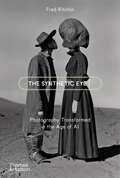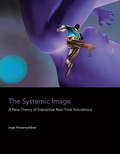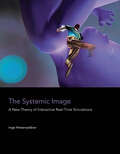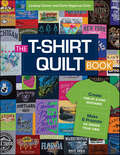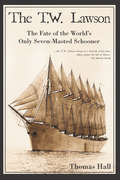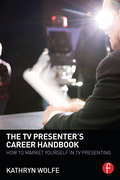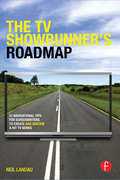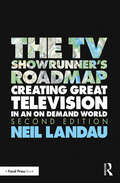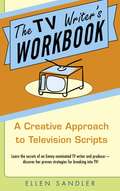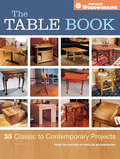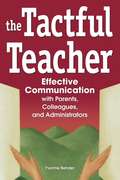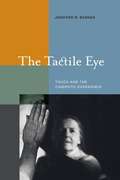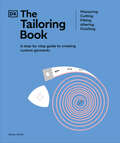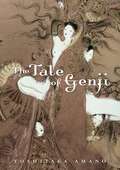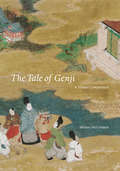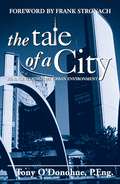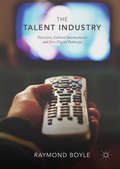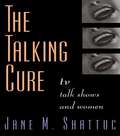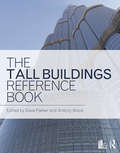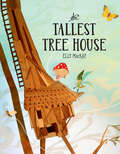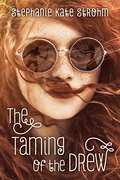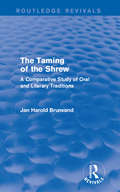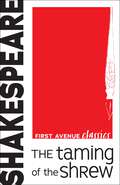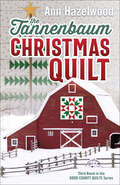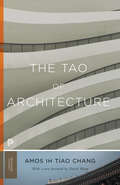- Table View
- List View
The Synthetic Eye: Photography Transformed in the Age of AI
by Fred RitchinA revelatory glimpse into the future of photography, one where the very nature of how images are created is fundamentally transformed by artificial intelligence. An invaluable roadmap in a new world. The revolution caused by artificial intelligence in terms of what a photograph can and cannot do is profound. This book looks at photography’s strengths, what it has meant for individuals and for society, its massive transformations caused by a variety of factors in the digital age, and the newer possibilities for image making. These include old and new media, with an emphasis on synthetic imaging as both a positive and terrifying development. In 1840, a year after photography’s invention, the painter Paul Delaroche exclaimed, “From now on, painting is dead.” Photography was quicker and cheaper as a representational medium and more realistic, its invention also liberated painters to become much more adventurous, embracing approaches that included impressionism, cubism, minimalism, and abstract expressionism. So too photographers are being challenged today. Many have responded with new strategies, but more innovation is needed. Can photographers be as radically expansive and revolutionary as painters were? Can they preserve or even expand the photograph’s role in society as a credible witness? Can the photographic image morph into forms previously unimagined? The Synthetic Eye is about this transformative revolution. How can synthetic imagery be utilized to amplify our understanding of ourselves and our worlds? Can an alternative photography deepen and expand the medium’s previous reach? What are the pitfalls? How will our senses of the real, the possible, and the actual be affected?
The Systemic Image: A New Theory of Interactive Real-Time Simulations
by Inge HinterwaldnerComputer simulations conceive objects and situations dynamically, in their changes and progressions. In The Systemic Image, Inge Hinterwaldner considers not only the technical components of dynamic computer simulations but also the sensory aspects of the realization. Examining the optic, the acoustic, the tactile, and the sensorimotor impressions that interactive real-time simulations provide, she finds that iconicity plays a dominant yet unexpected role. Based on this, and close readings of a series of example works, Hinterwaldner offers a new conceptualization of the relationship between systemic configuration and the iconic aspects in these calculated complexes.Hinterwaldner discusses specifications of sensorialization, necessary to make the simulation dynamic perceivable. Interweaving iconicity with simulation, she explores the expressive possibilities that can be achieved under the condition of continuously calculated explicit changes. She distinguishes among four levels of forming: the systems perspective, as a process and schema that establishes the most general framework of simulations; the mathematical model, which marks off the boundaries of the simulation's actualization; the iconization and its orientation toward the user; and interaction design, necessary for the full unfolding of the simulation. The user makes manifest what is initially latent. Viewing the simulation as an interface, Hinterwaldner argues that not only does the sensorially designed aspect of the simulation seduce the user but the user also makes an impact on the simulation -- on the dynamic and perhaps on the iconization, although not on the perspectivation. The influence is reciprocal.
The Systemic Image: A New Theory of Interactive Real-Time Simulations (The\mit Press Ser.)
by Inge HinterwaldnerA new conceptualization of the relationship between the systemic and the iconic in real-time simulations that distinguishes among four levels of forming.Computer simulations conceive objects and situations dynamically, in their changes and progressions. In The Systemic Image, Inge Hinterwaldner considers not only the technical components of dynamic computer simulations but also the sensory aspects of the realization. Examining the optic, the acoustic, the tactile, and the sensorimotor impressions that interactive real-time simulations provide, she finds that iconicity plays a dominant yet unexpected role. Based on this, and close readings of a series of example works, Hinterwaldner offers a new conceptualization of the relationship between systemic configuration and the iconic aspects in these calculated complexes.Hinterwaldner discusses specifications of sensorialization, necessary to make the simulation dynamic perceivable. Interweaving iconicity with simulation, she explores the expressive possibilities that can be achieved under the condition of continuously calculated explicit changes. She distinguishes among four levels of forming: the systems perspective, as a process and schema that establishes the most general framework of simulations; the mathematical model, which marks off the boundaries of the simulation's actualization; the iconization and its orientation toward the user; and interaction design, necessary for the full unfolding of the simulation. The user makes manifest what is initially latent. Viewing the simulation as an interface, Hinterwaldner argues that not only does the sensorially designed aspect of the simulation seduce the user but the user also makes an impact on the simulation—on the dynamic and perhaps on the iconization, although not on the perspectivation. The influence is reciprocal.
The T-Shirt Quilt Book: Recycle Your Tees into One-of-a-Kind Keepsakes
by Carla Hegeman Crim Lindsay ConnerNext stop, memory lane! Turn treasured tees into something brand new—a T-shirt quilt! Capture the memories of a special time, starting with a quick pillow project or a baby quilt made from onesies, and work your way up to bed quilts in multiple sizes. Learn the secrets to choosing shirts, centering and cutting out around a logo, working with shirts that are too small, and interfacing knit fabrics with finesse. You'll practice your skills with 8 projects ranging from simple squares to pieced stars and triangles, plus easy machine-appliquéd motifs. With beginner-friendly designs and truly unique layouts to entice experienced quilters, this essential guide to T-shirt quilts covers all the bases. • Wrap yourself in the warmth of well-worn tees! Stretch a small collection with other clothing fabric, purchased knits, and quilter’s cotton • Make your first quilt with simple piecing and easy machine appliqué, or try intermediate and advanced layouts • Have no fear of sewing with knits! Finish T-shirt quilts that will stand the test of time
The T.W. Lawson: The Fate of the World's Only Seven-Masted Schooner
by Thomas HallArmed with curiosity and a desire to piece together the story of the world's only seven-masted schooner, Tom Hall spent several years researching on both sides of the Atlantic, diving on the Lawson wreck and interviewing the relatives of those involved in the rescue efforts. The result of his work is the most complete account of the T. W. Lawson's story, ranging from her building and launch to her fated wreck off the Scilly Isles.
The TV Presenter's Career Handbook: How to Market Yourself in TV Presenting
by Kathryn WolfeYou can present to camera, speak to time, read autocue, conduct an interview, write and memorise scripts; you have a showreel, headshots and a CV—but what next? How do you decide which genre to go for, market yourself and establish your career? The TV Presenter’s Career Handbook is full of information and advice on how to capitalise on your presenter training and contains up-to-date lists of resources to help you seek work, market yourself effectively, and increase your employability. Contents include raising your profile, what kinds of companies to aim for and how to contact them, what to do with your programme idea, video and radio skills, creating your own TV channel, tips from agents, specialist genres such as News, Sports, Technology, Children’s and Shopping channels, breaking into the US, and more! Features interviews and case studies with over 80 experts so you can learn from those who have been there first, including: Maxine Mawhinney and Julian Worricker BBC News anchors, Jon Bentley and Jason Bradbury presenters The Gadget Show, Melvin Odoom KISS FM, Gemma Hunt presenter Swashbuckle, Matt Lorenzo presenter Premier League, Tony Tobin chef/presenter Ready Steady Cook and Saturday Kitchen, Alison Keenan and Marie-Francoise Wolff presenters QVC, Maggie Philbin and Jem Stansfield presenters Bang Goes the Theory, Kate Russell presenter BBC Click, Sarah Jane Cass Senior Talent Agent Somethin’ Else Talent, Emma Barnett award-winning radio presenter, David McClelland Technology presenter Rip Off Britain, Louise Houghton and Tina Edwards presenters London Live, Fran Scott presenter Absolute Genius with Dick and Dom, and Claire Richmond founder findatvexpert.com
The TV Showrunner's Roadmap: 21 Navigational Tips for Screenwriters to Create and Sustain a Hit TV Series
by Neil LandauIf you’ve ever dreamed of being in charge of your own network, cable, or web series, then this is the book for you. The TV Showrunner’s Roadmap provides you with the tools for creating, writing, and managing your own hit show. Combining his 20+ years as a working screenwriter and UCLA professor, Neil Landau expertly guides you through 21 essential insights to the creation of a successful show, and takes you behind the scenes with exclusive and enlightening interviews with showrunners from some of TV’s most lauded series, including: Breaking Bad Homeland Scandal Modern Family The Walking Dead Once Upon a Time Lost House, M.D. Friday Night Lights The Good Wife From conception to final rewrite, The TV Showrunner’s Roadmap is an invaluable resource for anyone seeking to create a series that won’t run out of steam after the first few episodes. This groundbreaking guide features a companion website with additional interviews and bonus materials. www.focalpress.com/cw/landau So grab your laptop, dig out that stalled spec script, and buckle up. Welcome to the fast lane.
The TV Showrunner's Roadmap: Creating Great Television in an On Demand World
by Neil LandauThis all-new edition of the best-selling guide The TV Showrunner’s Roadmap provides readers with the tools for creating, writing, and managing your own hit streaming series. Combining his 30+ years as a working screenwriter and professor, industry veteran Neil Landau expertly unpacks essential insights to the creation of a successful show and takes readers behind the scenes with exclusive and enlightening interviews with showrunners from some of TV’s most lauded series, including Fargo, Better Call Saul, Watchmen, Insecure, Barry, Money Heist, Succession, Ozark, Schitt’s Creek, Euphoria, PEN15, and many more. From conception to final rewrite, The TV Showrunner’s Roadmap is an invaluable resource for anyone seeking to create a series that won’t run out of steam after the first few episodes. This groundbreaking guide features an eResource with additional interviews and bonus materials. So grab your laptop, dig out that stalled spec script, and buckle up. Welcome to the fast lane.
The TV Writer's Workbook: A Creative Approach To Television Scripts
by Ellen SandlerWhy is TV writing different from any other kind of writing? How will writing a spec script open doors? What do I have to do to get a job writing for TV? Writing for television is a business. And, like any business, there are proven strategies for success. In this unique hands-on guide, television writer and producer Ellen Sandler shares the trade secrets she learned while writing for hit shows like Everybody Loves Raymond and Coach. She offers concrete advice on everything from finding a story to getting hired on a current series.Filled with easy-to-implement exercises and practical wisdom, this ingenious how-to handbook outlines the steps for becoming a professional TV writer, starting with a winning script. Sandler explains the difference between "selling" and "telling," form and formula, theme and plot. Discover:* A technique for breaking down a show style so you're as close to being in the writing room as you can get without actually having a job there* The 3 elements for that essential Concept Line that you must havein order to create a story with passion and consequence* Mining the 7 Deadly Sins for fresh and original story lines* Sample scripts from hit shows* In-depth graphs, script breakdown charts, vital checkpointsalong the way, and much, much more!From the Trade Paperback edition.
The Table Book: 35 Classic to Contemporary Projects
by Editors of Popular WoodworkingBuild a table of any style for any occasion Need a table? The Table Book is just what you need. It contains 35 projects to choose from, each with complete plans, cutting lists and detailed step-by-step instructions. You can learn new woodworking techniques or improve or update your skills. Here are some of the table styles you can choose to build: Shaker candle stand Greene & Greene table Stickley poppy table Porringer side table Prairie-style coffee table Maloof table Creole table Queen Anne side table Modern occasional table Nakashima-inspired table and 25 more!
The Tactful Teacher
by Yvonne BenderBy equipping teachers with the tools they need to communicate effectively with colleagues, parents, and administrators, this handbook prepares them to deal successfully with and understand the dynamics of a variety of work-related situations. Especially helpful for those new to the field, this guide teaches the skills to build effective communication, tailor messages to fit their recipients, and interact with difficult people and under pressure. Using specific scenarios, such as dealing with angry parents, sharing unpleasant information, or communicating in less-than-ideal school environments, different communication strategies, and why they work, are discussed in detail. Advice is also given on handling "The Social Addiction Trap" and those tricky "what's your opinion" questions with grace and aplomb.
The Tactile Eye: Touch and the Cinematic Experience
by Jennifer M. BarkerThe Tactile Eye expands on phenomenological analysis and film theory in its accessible and beautifully written exploration of the visceral connection between films and their viewers and combines analysis of embodiment and phenomenological film theory.
The Tailoring Book: Measuring. Cutting. Fitting. Altering. Finishing
by Alison SmithWhether you want to alter a vintage jacket or create a full-tailored suit, this tailoring reference guide has everything you need to produce elegant, bespoke garments that last a lifetime.With over 80 step-by-step techniques on measuring, cutting, altering, and finishing, this is the only book you will need to create and alter a tailored garment.Alison Smith MBE is one of the world's leading tailoring experts, and in her new book, she reveals trade secrets and all the practical know-how necessary to master this heritage craft. The Tailoring Book is the latest title in Smith's best-selling sewing series. It covers everything from choosing patterns and fabrics to fitting and construction, including techniques that can be applied to both womens- and menswear.With this book, you can learn how to:-Tailor garments by selecting the right tools to create a toile and picking the perfect hand stitch.-Follow 10 detailed garment projects to create shirts, jackets, coats, and trousers-Master the techniques of tailoring with step-by-step instructions and downloadable patterns that guide you through every part of the processThis book includes key equipment and techniques, garment projects with clear step-by-step processes and downloadable patterns, and tips on repairs and alterations. It takes the reader from the basics through to couture techniques.
The Tale of Genji
by Yoshitaka AmanoYoshitaka Amano has been praised around the world for his lush watercolors and evocative work dealing with myth and legend. In The Tale of Genji Mr. Amano brings his considerable talent to retelling one of the most famous of Japanese myths: written by Murasaki Shikibu shortly after 1000 AD and considered by most scholars to be the first novel ever written, The Tale of Genji is the story of the romantic adventures of Genji, the amazingly handsome prince and his many romantic conquests. Told through stunning paintings, Mr. Amano brings this classic story to life for a new generation.• As one of the most respected stories of all time, The Tale of Genji holds a worldwide place of honor among lovers of myth and legend.
The Tale of Genji: A Visual Companion
by Melissa McCormickAn illustrated guide to one of the most enduring masterworks of world literatureWritten in the eleventh century by the Japanese noblewoman Murasaki Shikibu, The Tale of Genji is a masterpiece of prose and poetry that is widely considered the world’s first novel. Melissa McCormick provides a unique companion to Murasaki’s tale that combines discussions of all fifty-four of its chapters with paintings and calligraphy from the Genji Album (1510) in the Harvard Art Museums, the oldest dated set of Genji illustrations known to exist.In this book, the album’s colorful painting and calligraphy leaves are fully reproduced for the first time, followed by McCormick’s insightful essays that analyze the Genji story and the album’s unique combinations of word and image. This stunning compendium also includes English translations and Japanese transcriptions of the album’s calligraphy, enabling a holistic experience of the work for readers today. In an introduction to the volume, McCormick tells the fascinating stories of the individuals who created the Genji Album in the sixteenth century, from the famous court painter who executed the paintings and the aristocrats who brushed the calligraphy to the work’s warrior patrons and the poet-scholars who acted as their intermediaries.Beautifully illustrated, this book serves as an invaluable guide for readers interested in The Tale of Genji, Japanese literature, and the captivating visual world of Japan’s most celebrated work of fiction.
The Tale of a City: Re-engineering the Urban Environment
by Tony O'DonohueThere is a complex web of infrastructure behind the day-to-day operation of a Canadian city. Flick the switch and the light comes on; turn the tap and the water is there; flush the toilet and the sewage disappears. But what price are we paying for these services that make our lives easier? In an age of blackouts, water problems, overflowing sewers, dangerously smoggy skies, and overburdened highways - problems that have led to an increasingly fragile environment with serious consequences for all Canadians - author Tony O’Donohue offers The Tale of a City, an essential primer in helping us to understand and improve our relationships with our engineered and natural environments.
The Talent Industry: Television, Cultural Intermediaries and New Digital Pathways
by Raymond BoyleThis book explores how the digital multiplatform delivery of television is affecting the role performed by cultural intermediaries responsible for talent identification and development. Drawing on original research from key stakeholders across the television and social video sectors such as broadcasters, commissioning editors and talent agents, it investigates whether the process of digitization is offering new pathways to capture and nurture a diverse talent base within the UK television industry. It also provides an in-depth study of how the term ‘talent’ has historically been interpreted and understood within the UK television industry through the BBC and commercial PSB’s, such as ITV and Channel 4. The Talent Industry investigates how the traditional gatekeepers of talent in television are changing and examines the key role of talent agencies in managing and promoting contemporary on and off-screen talent in the digital age.
The Talking Cure: TV Talk Shows and Women
by Jane M. ShattucThe Talking Cure examines four nationally syndicated television talk shows--Donahue, The Oprah Winfrey Show, Geraldo and Sally Jessy Raphael--which are primarily devoted to feminine culture and issues. Serving as one of the few public forums where working-class women and those with different sexual orientations have a voice, these talk shows represent American TV at its most radical. Shattuc examines the tension between talk's feminist politics and the television industry, who, in their need to appeal to women, trades on sensation, stereotypes and fears in order to engender product consumption. However, this genre is not a one-way form of social interaction. The female audience complies and resists in a complex give-and-take, and it is this relationship which The Talking Cure aims to understand and reveal.
The Tall Buildings Reference Book
by Antony Wood Dave ParkerAs the ever-changing skylines of cities all over the world show, tall buildings are an increasingly important solution to accommodating growth more sustainably in today’s urban areas. Whether it is residential, a workplace or mixed use, the tower is both a statement of intent and the defining image for the new global city. The Tall Buildings Reference Book addresses all the issues of building tall, from the procurement stage through the design and construction process to new technologies and the building’s contribution to the urban habitat. A case study section highlights the latest, the most innovative, the greenest and the most inspirational tall buildings being constructed today. A team of over fifty experts in all aspects of building tall have contributed to the making of the Tall Buildings Reference Book, creating an unparalleled source of information and inspiration for architects, engineers and developers.
The Tallest Tree House
by Elly MacKayFrom esteemed author-illustrator Elly MacKay comes a magical fantasy tale about the importance of working as a team and being a good friend.Mip and Pip are two fairies who live in a beautiful forest near a waterfall. One day, Mip has a brilliant idea to build a tree house and decides to make it into a contest: whoever can build the tallest tree house the fastest wins! Pip, who is much more thoughtful and a planner, reads about architecture and sketches out blueprints while Mip, the speedster, is already halfway done constructing her house. But when a powerful gust of wind threatens Mip's tree house and Pip's safety, the two friends must learn to appreciate each other's talents to save the day-and to build the tallest tree house in the forest.
The Taming of the Drew
by Stephanie Kate StrohmCass McKay has been called stubborn, temperamental, difficult, and that word that rhymes with "witch” more times than she cares to count. But that’s all about to pay off. She has finally landed the role she was born to play-Kate, in The Taming of the Shrew-in the summer apprentice program of a renowned Shakespeare theater company in the forests of Vermont.But Cass can barely lace up her corset before her troubles begin. Her leading man, Drew, is a complete troll, and he’s going to ruin Cass’s summer. Even worse, Cass’s bunkmate Amy has somehow fallen head over heels for Drew. Cass can’t let Amy throw herself at a total jerk, so she comes up with a genius plan to give Drew the personality makeover he so desperately needs: they’ll tame Drew just as Petruchio tames Kate! But as Shakespeare’s classic plays out offstage, Cass finds it harder and harder to resist falling for Drew herself.The best kind of entertainment, The Taming of the Drew is smart, funny, fresh, and original. You’re going to love this badass heroine and her friends. You might even end up liking Drew, too.
The Taming of the Shrew: A Comparative Study of Oral and Literary Versions (Routledge Revivals)
by Jan Harold BrunvandWilliam Shakespeare’s The Taming of the Shrew has succeeded in surviving in contemporary culture, and has even managed to penetrate to the most modern media of mass communications. This book, first published in 1991, examines some of the different literary and oral versions of The Taming of the Shrew. This book is ideal for students of literature, drama, and theatre studies.
The Taming of the Shrew: Being The Original Of Shakespeare's 'taming Of The Shrew' Edited (classic Reprint) (First Avenue Classics ™)
by William ShakespeareLucentio comes to Padua to attend the university, but his attention is quickly captured by the lovely Bianca. He would do anything to marry her, including disguise himself as her Latin teacher. But a major obstacle stands in the way of Lucentio's intentions: Bianca's father will only allow Bianca to marry after her sister, Katherine, is married. Katherine is everything Bianca is not. She is ill-tempered, opinionated, and objects to the idea of marriage. When bold Petruchio arrives in Padua, however, he might just be the kind of suitor who could succeed in marrying Katherine. This is an unabridged version of English playwright William Shakespeare's romantic comedy, which was first published in 1623.
The Tannenbaum Christmas Quilt: Third Novel In The Door County Quilts Series (Door County Quilts Series #3)
by Ann HazelwoodAn artist confronts her former flame and new challenges with her quilt circle in this holiday mystery from the author of the Wine Country Quilt series. Claire Stewart continues her quilt adventures in her little hometown of Fish Creek in Door County, Wisconsin. This time, Claire must face her former lover, Dr. Austen Page, since his terrible accident. How does this awkward moment work out? Her new Door County relationship with the man wearing the red scarf is the first who wants to know. Meanwhile, The Quilters of the Door have a new member, Anna Marie Meyer, who has recently moved from Germany. She brings with her an antique Tannenbaum Christmas quilt that has been in her family for generations. Claire embarks on embracing Anna and a wonderful German Christmas, as well as navigating her complicated love life. Praise for Ann Hazelwood and her novels &“I found myself immersed in the tale of this extended family and this wonderful quaint town . . . You will laugh, cry and share in their hopes and dreams.&” —Community News &“Ann Hazelwood knows a few things about the human spirit, family and dreaming big. Add a mixture of the love of quilting and all the things Missouri historic and otherwise; you will experience the words and passion of this unique and gifted author. Enjoy the experience!&”—StreetScape Magazine
The Tao of Architecture
by David Wang Amos Ih ChangFrank Lloyd Wright first noted the affinity between modern Western architecture and the philosophy of the ancient Chinese writer Laotzu. In this classic work, Amos Ih Tiao Chang expands on that idea, developing the parallel with the aid of architectural drawings and Chinese paintings. Now with a new foreword by David Wang, this book reveals the vitality of intangible, or negative, elements. Chang writes that these qualities make architectonic forms "come alive, become human, naturally harmonize with one another, and enable us to experience them with human sensibility." The Tao of Architecture continues to be essential reading for understanding the intersection between architecture and philosophy.
